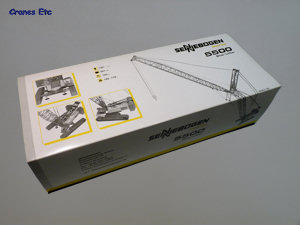 | | The box. | 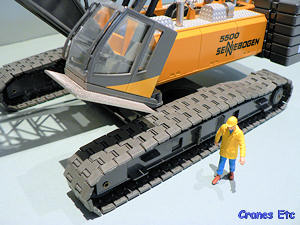 | | On the review model the tint of the yellow on the cab is just slightly different from the rest of the crane. |  | 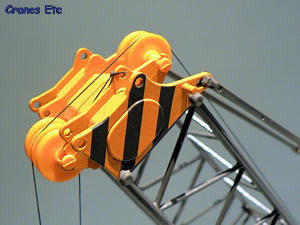 | | The main boom head showing lugs for attaching the jib. The large plastic pulleys do not roll well. | 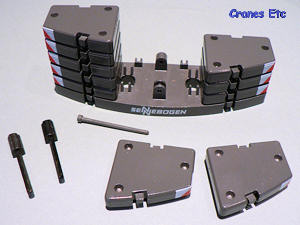 | | The pieces making up the counterweight shown together with two metal winding handles. | 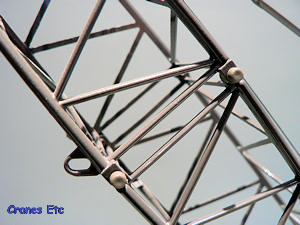 | | Jib and boom sections are joined by plastic bolts. |
| This was the first crawler crane from Conrad that was modular like the real machine and needed a lot of assembly by the collector.
Packaging
The box is relatively large for a model of this scale and consists of a picture sleeve containing two polystyrene sections. Opening the box reveals the nature of this model as the large number of individual pieces are seen packed into the two sections. The packaging holds the model well and the review model was undamaged. A relatively detailed instruction sheet is provided, complete with pictures, but it is only in German.
The original Conrad instructions for the four winch drums are incorrect to the real machine. Numbering the winch drums 1 to 4 from front to back:
- 1 is used for the hook when there is only a main boom or for the hook from the luffing jib if the crane is using two hooks;
- 2 is used for the hook on the main boom when the luffing jib is attached;
- 3 is a double drum and controls the luffing of the main boom using the pulleys on the A-frame (except the centre pulley);
- 4 controls the luffing jib - the rope goes under and around the single pulley on the body and then up and over the centre pulley on the A-frame and on up to the luffing gear pulleys.
Detail
Each crawler track comes as a separate unit. The tracks themselves are plastic made up of a large number of interlocking sections. They look very good although they are occasionally a little stiff so do not always lie naturally. The only other moving parts on the track frame are the main sprockets. In all the tracks are effective and quite free-rolling.
The main piece of the model crane consists of the cross frame that links the two track frames, the crane body and first section of boom. The cross frame snaps into position into openings in the track frames and this provides a robust fixing mechanism.
The cab is nicely detailed with grab handles and good interior details such as foot pedals. The main body is relatively uncomplicated except at the rear where the counterweight attachment mechanism is modelled well, and is complete with cylinders and lifting chains although the cylinder pistons would look better if they were silver rather than yellow. Four separate winches are available to be used: one for luffing the main boom, one for the luffing jib and two winch lines. The pulleys, and there are a lot of them on the main part of the model, are all plastic. They are tightly packed and some have slight burrs from the moulding process which tends to mean they are not very free-running.
The counterweight itself consists of a main plate which attaches with a pin and pairs of five weights. Each counterweight piece is cast with lifting lugs and is painted to produce a very pleasing result. Not included on the model are the ballast plates used on the real machine which span between the track frames front and rear. These would have added to the stability of the model which is fine with the jibs high but less so when they are at a big radius.
The first section of the main boom is permanently fixed to the crane body together with spring-loaded bars to prevent the boom being over luffed into a vertical position. This works well although it seems that the boom should be able to go more vertical than the model allows. All sections of the boom are made extremely well and look just great. They join together using the plastic pin system which is very effective and as they are the same colour as the jib they are unobtrusive. The main boom head has snap-in large plastic pulleys which are satisfactory but perhaps not the best in their ability to free-roll or their colour match, and they also appear to have an over-large separation between the sheaves. With the luffing jib attached an excellent cable arrangement is provided to prevent the fly jib over-luffing although the line itself is a little too stiff to hang naturally. The pendant bars used to support the jibs are all modelled in tough plastic and are reasonably good. Presumably plastic has been chosen to reduce the weight of these elements and to make them more robust than the alternative of very thin metal sections. Die cast zinc is not ductile and so would be prone to snapping under load. There is no dolly wheel at the end of the fly jib.
The hook is a bit of a disappointment as it is only a single pulley affair. It is metal and looks fine on the fly jib but the main boom really calls for something which is a little more substantial.
Features
The cab is mounted on a tilting and hinge arrangement so that it can be moved inward to reduce the crane width during transport and can be rotated upward to aid the driver during lifts at height. As a minor detail it would have been better if the walkway outside the cab had been hinged so that it can be stowed during transportation. When placed on a low loader this part of the model increases the width just a little too much.
The four winches are operated by keys which on this model are metal. They can also be removed when not used so they do not distract from the look and this is an excellent approach.
The main strength of this model is the large variety of ways the model can be displayed. It can be fully broken down for transport so looks excellent on the appropriate haulage vehicles. The crane can be rigged a number of ways. It can have just a main boom of various lengths, including very short if you want it. It can have a luffing jib of different lengths. Another option arises because the top of the main boom head can be removed and jib sections directly attached to create a long boom with reducing section towards the top.
Quality
This model set a new standard for mass-produced crawler crane models when introduced and it is a very good looking piece. Rigging the model takes some time and the instructions are not as clear as they could be so a complete novice might have some difficulty. In particular stringing up the luffing hoists requires patience and perseverance. The casting of the boom sections is very good and overall the model has a high quality feel. The paint and graphics complete this image.
Price
The model is very good value for money having regard for quality and the large range of display choices that present themselves.
Overall
It is a model which perhaps led the way in terms of what could be achieved through mass production in this scale and it is a very good model of a large crawler crane. It could be further enhanced in some areas with metal tracks and ballast plates to aid stability and with further attention in some other areas of detailing.
Footnotes
The Sennebogen Starlifter crawler crane was first shown as a prototype at the Bauma Exhibition in 2001. It went on general sale in 2002. The base model comes with the full complement of ballast weights as per the real crane. An extension kit includes an extra main boom section and an extra jib section. It also has extra ballast weights which add stability to the model but in total are more than the real machine uses. The model was withdrawn from Conrad's online model list in February 2006. In December 2006 a version in Mammoet colours was introduced in a limited edition of 300 models. The extension set was also available in Mammoet colours. The model was revised in 2011 and issued as model number 2733/02. It was also produced in Franz Bracht colours.
|
| |
| 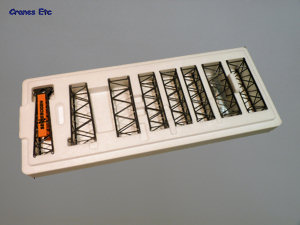 | | The top tray. | 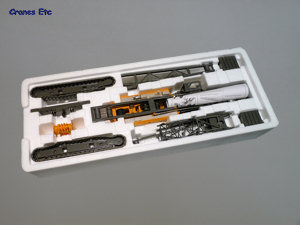 | | The bottom tray. | 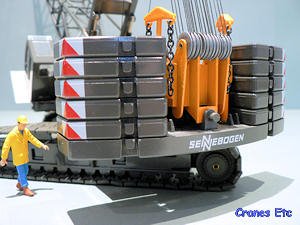 | | Counterweight tray is held in place by a single central pin which means it rocks a little. | 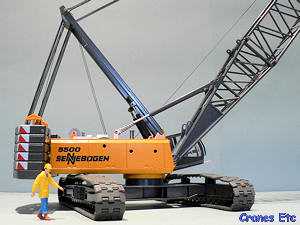 | | Holes in the body for the removable winch turning handles. | 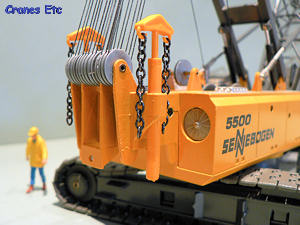 | | With the counterweight tray removed, the detail of the hydraulic tray lifting mechanism is clear and there is a well detailed grille at the rear. | 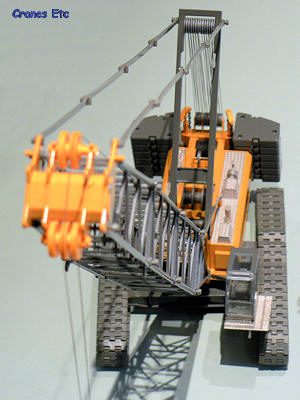 | | A well engineered model. |
|

